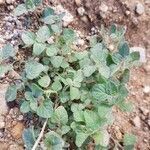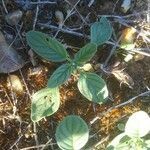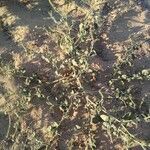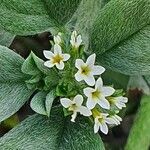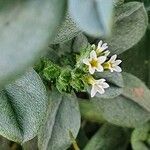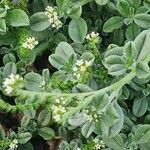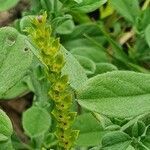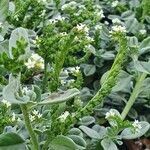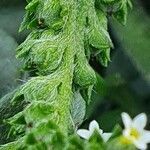Prostrate or decumbent annual herb usually with 4 main stems rising in a cross; stems up to 35 cm long, herbaceous, laterally compressed, ± densely clothed with retrorse appressed hairs, mixed with longer spreading ones. Leaves alternate however subopposite to the base; petiole 3-15 mm long (up to 27 mm on the basal leaves); lamina 10-35 x 7-19 mm, broadly ovate to broadly obovate, rarely trullate or circular, densely appressed-pubescent or strigose above, pubescent or tomentose and bristly on the nerves below, obtuse to truncate at apex, acute to obtuse and often very asymmetrical at base, the nerves usually deepened above, prominent below. Cymes short, often 1, rarely 2-3 on each terminal peduncle. Flowers sessile or subsessile. Calyx 2.0-2.8 mm long, enlarged up to 4.5(6) mm in fruit, bristly outside, appressed hairy inside; lobes cohering up to near apex, obtuse. Corolla as long as or but little longer than the calyx, persisting over the fruit; tube greenish, densely clothed with retrorse appressed hairs outside, glabrous inside; limb white, divided into 5 minute oblong subequal lobes. Anthers c. 1 mm long, linear, subsessile. Ovary globose, glabrous. Style c. 0.5 mm long with short retrorse hairs, sometimes subglabrous; sterile appendix c. 0.5 mm long, conical, shortly hairy at apex. Fruits up to 4 mm long, ovoid, plano-convex or excavated by abortion of 2-3 nutlets, glabrous, enclosed in the calyx; nutlets often 2, rarely 1, very rarely 3 or 4 with the outer and the inner surfaces granulate-tuberculate, brown with a lighter well developed edge; rarely the fruits wholly covered with a greyish corky layer concealing the ornamentation.
Leaves alternate however subopposite to the base; petiole 3–15 mm. long (up to 27 mm. on the basal leaves); lamina 10–35 x 7–19 mm., broadly ovate to broadly obovate, rarely trullate or circular, densely appressed-pubescent or strigose above, pubescent or tomentose and bristly on the nerves below, obtuse to truncate at apex, acute to obtuse and often very asymmetrical at base, the nerves usually deepened above, prominent below.
Annual herb, densely hairy. Stems procumbent, trailing. Leaves petiolate; blade broadly ovate to elliptic, 5-25 x 3-17 mm, veins deeply sunken on upper surface, prominent on lower surface; petioles 2-15 mm long. Flowers in helicoid cymes. Calyx ± as long as corolla tube. Corolla white, lobes rounded. Flowering time Mar.-Dec. Fruit enclosed by calyx, nutlets usually one, obscurely tuberculate on dorsal side, margins winged.
Fruits up to 4 mm. long, ovoid, plano-convex or excavated by abortion of 2–3 nutlets, glabrous, enclosed in the calyx; nutlets often 2, rarely 1, very rarely 3 or 4 with the outer and the inner surfaces granulate-tuberculate, brown with a lighter well developed edge; rarely the fruits wholly covered with a greyish corky layer concealing the ornamentation.
Prostrate or decumbent annual herb. Leaves small, broadly ovate to broadly obovate, 7-19 mm broad, hirsute, conspicuously petiolate, lateral nerves impressed above. Corolla lobes oblong. Cymes not bracteate. Fruit enclosed in calyx. Flowers with greenish tube and white limb.
Procumbent, annual or perennial herb, branches up to 300 mm long. Leaves broadly ovate to broadly obovate, densely adpressed-hairy, veins usually sunken above and prominent beneath. Flowers in a helicoid cyme, white. Nutlets smooth.
Corolla as long as or but little longer than the calyx, persisting over the fruit; tube greenish, densely clothed with retrorse appressed hairs outside, glabrous inside; limb white, divided into 5 minute oblong subequal lobes.
Prostrate or decumbent annual herb usually with 4 main stems rising in a cross; stems up to 35 cm. long, herbaceous, laterally compressed, ± densely clothed with retrorse appressed hairs, mixed with longer spreading ones.
Prostrate annual. Leaves broadly ovate to broadly obovate, densely adpressed-hairy, veins usually sunken above and prominent beneath. Flowers in a helicoid cyme, white. Nutlets smooth.
Calyx 2.0–2.8 mm. long, enlarged up to 4.5(6) mm. in fruit, bristly outside, appressed hairy inside; lobes cohering up to near apex, obtuse.
Style c. 0.5 mm. long with short retrorse hairs, sometimes subglabrous; sterile appendix c. 0.5 mm. long, conical, shortly hairy at apex.
Cymes short, often 1, rarely 2–3 on each terminal peduncle.
Hairy much-branched herb, decumbent from a woody base.
Anthers c. 1 mm. long, linear, subsessile.
Flowers sessile or subsessile.
Ovary globose, glabrous.
